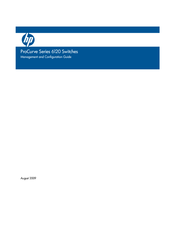HP PROCURVE 6120 Manuals
Manuals and User Guides for HP PROCURVE 6120. We have 1 HP PROCURVE 6120 manual available for free PDF download: Management And Configuration Manual
HP PROCURVE 6120 Management And Configuration Manual (589 pages)
ProCurve Series 6120 Switches
Table of Contents
-
-
-
Contents27
-
-
Introduction
28 -
Conventions
28 -
-
Contents64
-
-
-
Overview65
-
-
-
-
-
-
CLI Command149
-
Operating Notes150
-
Log Messages151
-
Sessions
162 -
IP Configuration
172-
Overview172
-
-
-
Contents216
-
-
-
Overview218
-
-
Error Messages227
-
-
-
Command228
-
-
Contents282
-
Jumbo Frames283
-
Overview283
-
Terminology283
-
Operating Rules284
-
Overview285
-
Jumbo IP MTU289
-
-
Troubleshooting292
-
-
Contents
293
-
-
-
Overview295
-
-
Enabling Snmpv3300
-
Snmpv3 Users300
-
-
Communities306
-
-
-
Terminology329
-
-
Lldp-Med331
-
-
Contents375
-
-
-
-
Overview377
-
Enabling TFTP383
-
Using Auto-TFTP385
-
How It Works387
-
Command Options389
-
Authentication390
-
Workstation393
-
-
-
-
-
Contents408
-
Overview
410 -
-
-
Menu Access415
-
CLI Access416
-
-
Port Status417
-
CLI Access417
-
Web Access417
-
-
VLAN Information427
-
-
Operating Notes452
-
-
Troubleshooting
455-
Contents455
-
Overview
458 -
-
General Problems463
-
-
-
-
Debug Command499
-
Debug Messages499
-
-
Logging Command502
-
Diagnostic Tools
510 -
-
DNS Resolver
533-
Terminology533
-
Basic Operation534
-
Operating Notes540
-
Contents542
-
Overview543
-
Contents549
-
-
-
Advertisement
Advertisement
